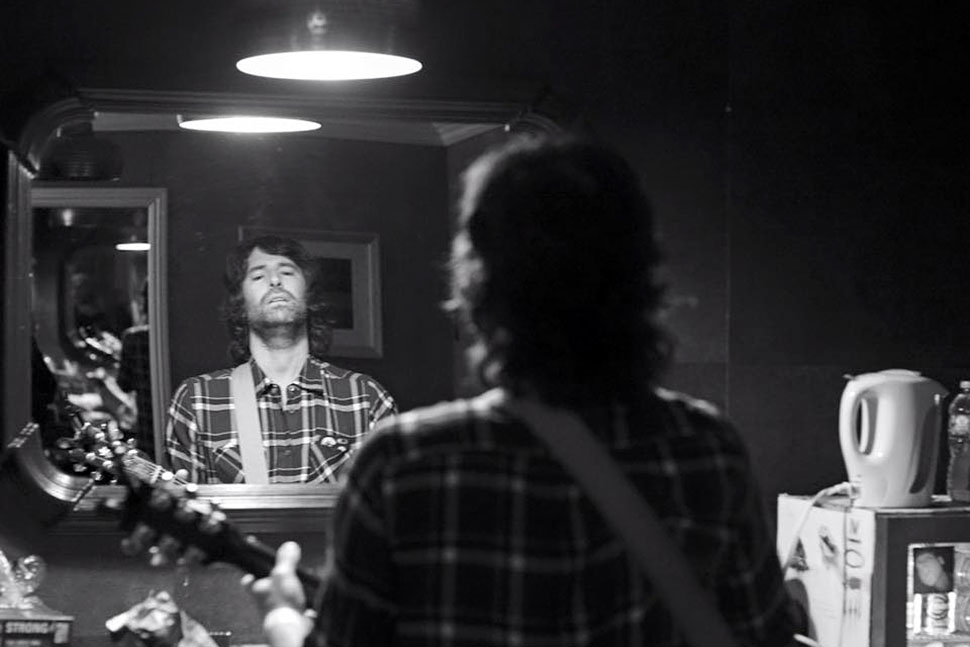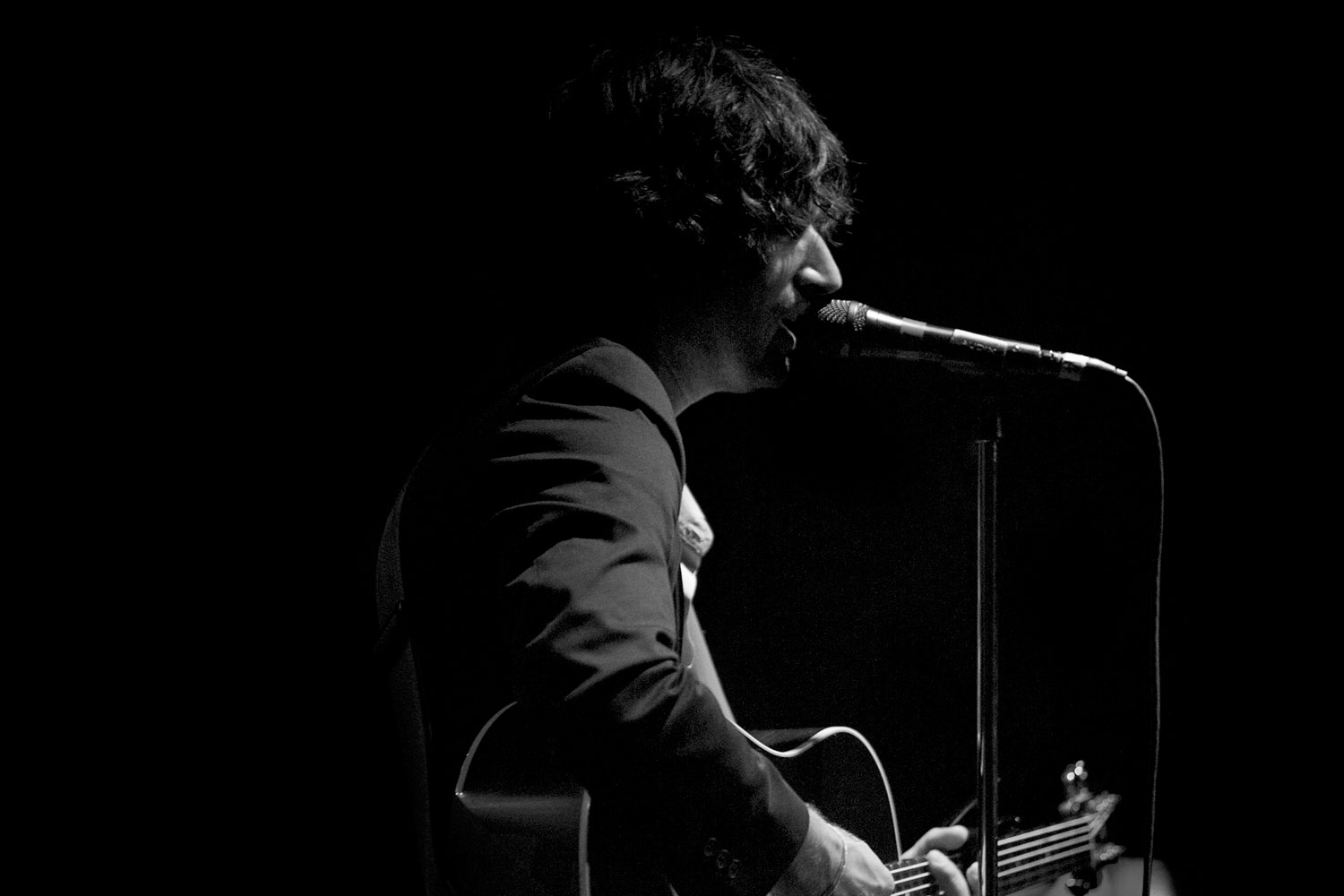
“I’m not going to be held back by the idea that everything has to have one sound.”
Coming full circle as an artist means you sometimes have to go back to the beginning. That’s what superstar singer/songwriter Pete Yorn (Life on a Chain, Come Back Home) did for his first full solo album in almost six years, ArrangingTime, out today from Capitol on various formats. From the gotta-leave-the-basement pleading of Lost Weekend to the sleepy-shimmery drawl of Shopping Mall to the climbing emotional pyre of This Fire, Yorn brings his yearning for multi-faceted mixes back to the forefront of his recorded palette.
“The way I approach this style of recording is I do what’s right for the kind of sonic bed we’re building up,” Yorn explained to Digital Trends. “I’ve made some records leading up to this one that sound kind of homogenous, where the same band played on everything in the same way of recording with the same producer using the same microphones, and all that.
“This style is the opposite, and definitely like the way I did my first couple of records,” Yorn continues, referring to the feel of his 2001 debut, Musicforthemorningafter, and its 2003 follow-up, Day I Forgot. “In a strange way, it’s almost like a mixtape. And it’s purposely done that way, because I’m not going to be held back by the idea that everything has to have one sound. I’ve done that. Sometimes it’s cool and I’m interested in that, but it didn’t make sense for what I was trying to do with this one.”
Digital Trends got Yorn on the horn (see what we did there?) to discuss the new record’s diverse sonic blueprint, whether to shuffle or not to shuffle album tracks, and saying yes to embracing modern recording sensibilities.
Digital Trends: In a way, this is a coming back home record for you, as you cut a number of tracks with Walt [i.e., R. Walt Vincent], whom you worked with on your first few albums. Did you guys come up with a game plan before you started recording as to how you wanted this album to sound?
Pete Yorn: Not so much sound as much as it was approach — as in, me and him getting in a room and playing most of the stuff ourselves, to get the feel. It’s more of a layering kind of process as opposed to getting a band together and tracking live in the studio. We have a different process, so it was definitely nice getting back with my old buddy to make some noise.
Streaming is what it is. I’m not trying to fight the power.
As far as the sound goes, that’s something that just develops as we start tracking. I’ll get a guitar part down, and depending on how it sounds and how we EQ it, it will evoke something where I’ll go, ”Hmm, how about we add this on top of it?” — something that has a certain sound to it that will take it somewhere else.
A lot of times I’ll go into the studio and say, “I have this idea that I want it to sound kind of Beach Boys-y.” And then it turns out sounding the fucking opposite of The Beach Boys! (chuckles) It’s funny how that happens.
Usually, I try to make it sound the way I think it should sound in my head, but then it ends up being not interesting to me, or it ends up going someplace completely different — and that’s my favorite thing. To me, stuff feels fresher that way.
Is there one track on ArrangingTime where you heard it in your head one way and then it went somewhere else completely?
Umm, let’s see… for This Fire, I went in and recorded four different versions of it. I did a Johnny Cash, chugging-train-tracks-sounding version, like a locomotive. It was cool; it was fine — but it ended up not sounding like that at all, as it become this slow, reggae kind of tune.
To me, it’s the perfect album-ending kind of song. Speaking of interesting layers, one of my favorite tracks right now is Shopping Mall. That’s a 3 a.m. song to me. It’s got an early in the morning feel to it.
All right!!! That’s a good choice, dude! Cool! That’s one of my favorites, too. Walt and I cut that one pretty early in the morning. It’s really sparse in the production, and, emotionally, it still gets to me. I’ve been living with it for a long time, but I really like how the tone of that one turned out.
Me too. I love the subtle echo effect on your vocal, and that laconic, laid-back way you sing each line.
Yeah, there’s a subtle approach to it, where I kinda let it go. Dude, one of my favorite lyrics on the record is the last line of the song.
Is that where you go, “I can’t tell you anything…”?
Right: “I can’t tell you anything you don’t already know/I can’t give you anything you don’t already have.” I don’t usually talk that much about my lyrics, but I do like those lines a lot. They resonate with me. I’ve covered that theme a few times from different angles, but people forget sometimes they have so much to give and don’t even realize it, you know?
That one’s pretty powerful. I immediate put that track into repeat mode — that one, and She Was Weird, which has a cool, dreamy vibe to it.
Cool! You sound like my brother, because those are his two favorite songs. I wrote She Was Weird on my acoustic guitar. It has a super-rootsy feel to it, almost like a Tom Petty song. And when I got with Sunny Levine [one of the album’s other producers, the son of Stewart Levine and grandson of Quincy Jones], I knew he would bring something fun to the table that I wouldn’t necessarily bring myself. I played it for him, and we got some fun sounds up. He’s great with beats. We took it to a new place, and I’m happy with it.
What’s the best way to listen to this album? Are you still a big vinyl guy?
Vinyl’s great! I’ve actually heard it on vinyl already, and it really sounds nice on it. But I think there is no one way to listen to it. I encourage people to listen to it their way.
I do what’s right for the kind of sonic bed we’re building up.
And I think it could be played in any order as well, even though I really worked hard on what I thought the best finished sequence would be. If you want to sit back and just let it flow, vinyl is good for that — to just let it ride.
But it’s also cool to be listened to on shuffle as well. The way people listen to music now is so funny — you’re just skipping around, and maybe you don’t even get through a full song on anyone’s record. You have someone’s whole freaking catalog right in your hand.
Maybe that’s why vinyl has become so popular again. People want to have that experience where they put on an album side and just hang out, let it play, and just take it all in that way.
Is there one particular album you’d put on and listen to from beginning to end exactly as it was sequenced?
Some of those [Rolling] Stones records, like Sticky Fingers (1971) — though sometimes I would go right to Side B and start there. [Side B of Sticky Fingers opens with Bitch.] That was a record I could always put on for any vibe and hang out, have some beers, play some backgammon, and let that record roll and get me pumped.
Oh yeah, Beers and Backgammon? That sounds like a title you gotta use for something.
I was working on another one called Champagne and Asparagus. (Both laugh)
OK, I want to hear that one when it’s finished. We all grew up with vinyl, but are you cool with the streaming universe?
I’m OK with it, but it definitely seems like the compensation for the artist is really bad. It is what it is right now, and I’m not trying to fight the power. Ultimately, it helps out music, and music is still very popular. But it’s definitely a little weird.
If I had to listen to this album via low-grade MP3s, I’d feel like I’d miss out on all the detail in a song like Halifax.
There’s always one song on all my albums that stands out as a pure recording in terms of its mix, and the best example of that to me consistently is Halifax. That one seems to be the most three-dimensional. It has a really nice sound, the way it turned out.
Halifax has a classic ’60s studio vibe to me, but with a modern sensibility. What’s a good headphones-only song or album for you?
There’s no one way to listen to this album. I encourage people to listen to it their way.
You know what recording sounds really amazing to me? It’s a pop song from the early ’80s, Video Killed the Radio Star. It’s so modern and interesting at the same time — an unbelievable recording. That one still sounds good to me — even on satellite radio, where it’s a bit compressed, it still jumps out at me. Whether you like that song or not, if you put on headphones and really listen to it, it sounds amazing.
Oh yeah, that’s the Buggles — Trevor Horn and Geoff Downes. Those two guys, as minimalistic as they were, got some great sounds on that record, and they’re both great producers, too.
That song’s done right. You hear all the separation. It’s a really great production, and it still sounds modern today — it’s thick and punchy, and still has that vibe.
I would agree with that. And I love how those guys became part of the Yes camp. Geoff plays keyboards in the current incarnation of Yes, and Trevor produced 90125, that great 1983 album of theirs.
That’s interesting, because another CD we used to play on these Boston Acoustics speakers my brother got sometime around 1987 or so, one that I remember sounding so incredible was a Yes song called, I think, something like Changes…?
Yes! Changes was on 90125. It’s one of [guitarist/vocalist] Trevor Rabin’s great contributions to that album that has many great moments of emotion, power, and dynamics.
That recording was so insane, too. Just so amazing!
Yeah, it has that slow fade-in, the drums get really intense, and then Trevor and Jon Anderson share those vocal tradeoffs. I’ve spoken to Trevor about it, as it’s my favorite track he did with Yes. [Rabin was in the band from 1983–94.] It’s his tour de force, really.
That’s awesome! So some of the guys who did that also did Video Killed the Radio Star?
Yes — Trevor Horn produced the 90125 album. And when Jon Anderson briefly left Yes, Horn and Geoff Downes joined the band for Drama (1980), where Trevor sang the lead vocals and Geoff played the keyboards. But Geoff wasn’t on 90125, since he was in the band Asia by that point. And Trevor went on to produce things like Frankie Goes to Hollywood, Pet Shop Boys, and Seal. There’s your rock history lesson for the day. (both laugh)
Wow! It’s a Trevor Horn kind of day! I never knew that was all connected. That’s really cool. And the way the acoustic comes in on Changes — again, it was that modern sound of the time that still sounds great today. They knew what they were doing.
I’m in total agreement with you there. Bringing it back around to ArrangingTime, this is a headphones album, too. There are so many great things to be discovered with repeated listening.
In my opinion, it’s a super-accessible record. It’s a pop record, but there’s a lot more going on than people might realize upon first listen. We definitely worked hard in adding a lot of layers where appropriate, and making sure that certain things were audible. That’s part of the fun, because I do like to have fun in the studio. (laughs)








